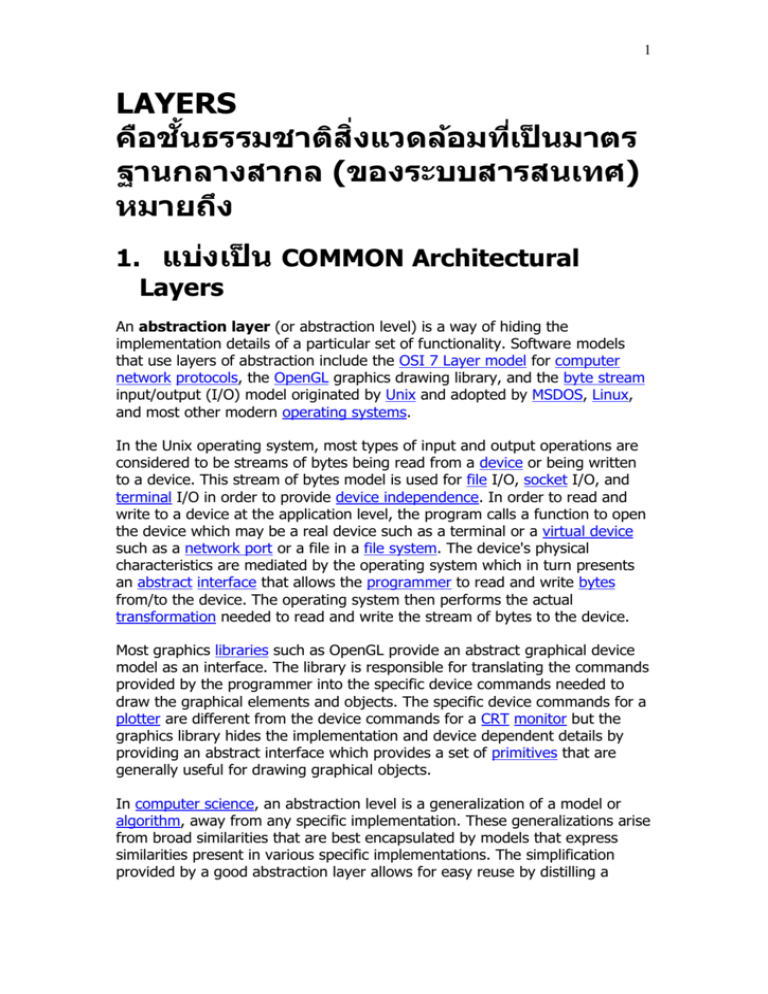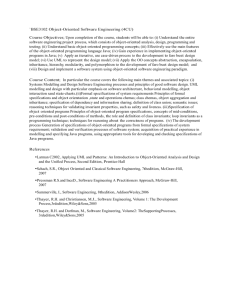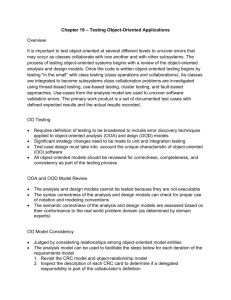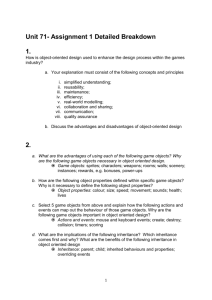Layers
advertisement

1 LAYERS ั้ คือชนธรรมชาติ สงิ่ แวดล้อมทีเ่ ป็นมาตร ฐานกลางสากล (ของระบบสารสนเทศ) หมายถึง 1. แบ่งเป็น COMMON Architectural Layers An abstraction layer (or abstraction level) is a way of hiding the implementation details of a particular set of functionality. Software models that use layers of abstraction include the OSI 7 Layer model for computer network protocols, the OpenGL graphics drawing library, and the byte stream input/output (I/O) model originated by Unix and adopted by MSDOS, Linux, and most other modern operating systems. In the Unix operating system, most types of input and output operations are considered to be streams of bytes being read from a device or being written to a device. This stream of bytes model is used for file I/O, socket I/O, and terminal I/O in order to provide device independence. In order to read and write to a device at the application level, the program calls a function to open the device which may be a real device such as a terminal or a virtual device such as a network port or a file in a file system. The device's physical characteristics are mediated by the operating system which in turn presents an abstract interface that allows the programmer to read and write bytes from/to the device. The operating system then performs the actual transformation needed to read and write the stream of bytes to the device. Most graphics libraries such as OpenGL provide an abstract graphical device model as an interface. The library is responsible for translating the commands provided by the programmer into the specific device commands needed to draw the graphical elements and objects. The specific device commands for a plotter are different from the device commands for a CRT monitor but the graphics library hides the implementation and device dependent details by providing an abstract interface which provides a set of primitives that are generally useful for drawing graphical objects. In computer science, an abstraction level is a generalization of a model or algorithm, away from any specific implementation. These generalizations arise from broad similarities that are best encapsulated by models that express similarities present in various specific implementations. The simplification provided by a good abstraction layer allows for easy reuse by distilling a 2 useful concept or metaphor so that situations where it may be accurately applied can be quickly recognized. A good abstraction will generalize that which can be made abstract; while allowing specificity where the abstraction breaks down and its successful application requires customization to each unique requirement or problem. Frequently abstraction layers can be composed into a hierarchy of abstraction levels. The ISO-OSI networking model comprises seven abstraction layers. Each layer of the OSI ISO networking model encapsulates and addresses a different part of the needs of much digital communications thereby reducing the complexity of the associated engineering solutions. A famous aphorism of David Wheeler goes: All problems in computer science can be solved by another level of indirection;[2] this is often deliberately misquoted with "abstraction" substituted for "indirection". Kevlin Henney's corollary to this is, "...except for the problem of too many layers of indirection." A typical vision of a computer architecture as a series of abstraction layers: hardware, firmware, assembler, kernel, operating system and applications (see also[1]). 2. Common layers in an information system logical architecture ั้ คือชนธรรมชาติ สงิ่ แวดล้อมทีเ่ ป็นมาตรฐานกลางสากล 3 (ของระบบสารสนเทศ) Common LAYSERS / TIER in an information system logical architecture หมายถึง 2.1. In object-oriented design, a layer is a group of classes that have the same set of link-time module dependencies to other modules. In other words, a layer is a group of reusable components that are reusable in similar circumstances. In programming languages, the layer distinction is often expressed as "import" dependencies between software modules. 2.2. Layers are often arranged in a tree-form hierarchy, with dependency relationships as links between the layers. Dependency relationships between layers are often either inheritance, composition or aggregation relationships, but other kinds of dependencies can also be used. 2.3. Layers is an architectural pattern described in many books, for example Pattern-Oriented Software Architecture 2.4. การออกแบบสถาปั ตยกรรมโปรแกรมคอมพิวเตอร์ ั ้ อะไร (Application) ต ้องดูวา่ โปรแกรมฯ ทางานชน 3. layer is a logical structuring mechanism for the elements that make up your software solution 4 3.1. n-tier or CLIENT/ SERVER or Multi-TIER ARCHITECTURE or n-TIER 3.2. Architecture is a physical structuring mechanism for the system infrastructure. 3.3. Object-oriented design "OOD" redirects here. OOD may also refer to Officer of the Deck, Officer of the day, or the Ood. Object-oriented design is the process of planning a system of interacting objects for the purpose of solving a software problem. It is one approach to software design. 5 3.3.1. Contents (1) 1 Overview (2) 2 Object-oriented design topics Input 2.1 (sources) for object-oriented design 2.2 Object-oriented concepts 2.3 Designing concepts 2.4 (deliverables) of object-oriented design 2.5 Some design principles and strategies Output Overview An object contains encapsulated data and procedures grouped together to represent an entity. The 'object interface', how the object can be interacted with, is also defined. An object-oriented program is described by the interaction of these objects. Object-oriented design is the discipline of defining the objects and their interactions to solve a problem that was identified and documented during object-oriented analysis. What follows is a description of the class-based subset of object-oriented design, which does not include object prototype-based approaches where objects are not typically obtained by instancing classes but by cloning other (prototype) objects. Object-oriented design topics Input (sources) for object-oriented design The input for object-oriented design is provided by the output of objectoriented analysis. Realize that an output artifact does not need to be completely developed to serve as input of object-oriented design; analysis and design may occur in parallel, and in practice the results of one activity can feed the other in a short feedback cycle through an iterative process. Both analysis and design can be performed incrementally, and the artifacts can be continuously grown instead of completely developed in one shot. Some typical input artifacts for object-oriented design are: Conceptual model: Conceptual model is the result of object-oriented analysis, it captures concepts in the problem domain. The conceptual 6 model is explicitly chosen to be independent of implementation details, such as concurrency or data storage. Use case: Use case is description of sequences of events that, taken together, lead to a system doing something useful. Each use case provides one or more scenarios that convey how the system should interact with the users called actors to achieve a specific business goal or function. Use case actors may be end users or other systems. In many circumstances use cases are further elaborated into use case diagrams. Use case diagrams are used to identify the actor (users or other systems) and the processes they perform. System Sequence Diagram: System Sequence diagram (SSD) is a picture that shows, for a particular scenario of a use case, the events that external actors generate, their order, and possible inter-system events. User interface documentations (if applicable): Document that shows and describes the look and feel of the end product's user interface. It is not mandatory to have this, but it helps to visualize the end-product and therefore helps the designer. Relational data model (if applicable): A data model is an abstract model that describes how data is represented and used. If an object database is not used, the relational data model should usually be created before the design, since the strategy chosen for objectrelational mapping is an output of the OO design process. However, it is possible to develop the relational data model and the object-oriented design artefacts in parallel, and the growth of an artefact can stimulate the refinement of other artefacts. Object-oriented concepts The five basic concepts of object-oriented design are the implementation level features that are built into the programming language. These features are often referred to by these common names: Object/Class: A tight coupling or association of data structures with the methods or functions that act on the data. This is called a class, or object (an object is created based on a class). Each object serves a separate function. It is defined by its properties, what it is and what it can do. An object can be part of a class, which is a set of objects that are similar. Information hiding: The ability to protect some components of the object from external entities. This is realized by language keywords to enable a variable to be declared as private or protected to the owning class. 7 Inheritance: The ability for a class to extend or override functionality of another class. The so-called subclass has a whole section that is derived (inherited) from the superclass and then it has its own set of functions and data. Interface: The ability to defer the implementation of a method. The ability to define the functions or methods signatures without implementing them. Polymorphism: The ability to replace an object with its subobjects. The ability of an object-variable to contain, not only that object, but also all of its subobjects. Designing concepts Defining objects, creating class diagram from conceptual diagram: Usually map entity to class. Identifying attributes. Use design patterns (if applicable): A design pattern is not a finished design, it is a description of a solution to a common problem, in a context[1]. The main advantage of using a design pattern is that it can be reused in multiple applications. It can also be thought of as a template for how to solve a problem that can be used in many different situations and/or applications. Object-oriented design patterns typically show relationships and interactions between classes or objects, without specifying the final application classes or objects that are involved. Define application framework (if applicable): Application framework is a term usually used to refer to a set of libraries or classes that are used to implement the standard structure of an application for a specific operating system. By bundling a large amount of reusable code into a framework, much time is saved for the developer, since he/she is saved the task of rewriting large amounts of standard code for each new application that is developed. Identify persistent objects/data (if applicable): Identify objects that have to last longer than a single runtime of the application. If a relational database is used, design the object relation mapping. Identify and define remote objects (if applicable). Output (deliverables) of object-oriented design Sequence Diagrams: Extend the System Sequence Diagram to add specific objects that handle the system events. 8 A sequence diagram shows, as parallel vertical lines, different processes or objects that live simultaneously, and, as horizontal arrows, the messages exchanged between them, in the order in which they occur. Class diagram: A class diagram is a type of static structure UML diagram that describes the structure of a system by showing the system's classes, their attributes, and the relationships between the classes. The messages and classes identified through the development of the sequence diagrams can serve as input to the automatic generation of the global class diagram of the system. Some design principles and strategies Dependency injection: The basic idea is that if an object depends upon having an instance of some other object then the needed object is "injected" into the dependent object; for example, being passed a database connection as an argument to the constructor instead of creating one internally. Acyclic dependencies principle: The dependency graph of packages or components should have no cycles. This is also referred to as having a directed acyclic graph. [2] For example, package C depends on package B, which depends on package A. If package A also depended on package C, then you would have a cycle. Composite reuse principle: Favor polymorphic composition of objects over inheritance.[1] 3.4 The following four layers are the most common layers in a logical multilayered architecture for an information system with an object-oriented design: Common layers in an information system logical architecture 3.4.1 3.4.2 3.4.3 3.4.4 User Interface Layer (aka View Layer, UI layer or Presentation layer) Application Layer (aka Service Layer[1][2] or GRASP Controller Layer [3]) Domain Layer (aka Business Layer, Business logic Layer or Model Layer) Infrastructure Layer (data access or other persistence, logging, network I/O e.g. sending emails, and other kind of technical services) 9 Some common purposes of the above four layers are for example described in the book about domain-driven design [4] at page 68-74, which is a book that otherwise is focused on describing the Domain layer Sometimes there is no explicit distinction between the Domain Layer and the Application Layer, e.g. the Application Layer is considered as being a part of the Domain Layer. On the other hand, it is also possible to even further divide the Application/Domain Layers into more layers. For example, if the Model View Presenter pattern is used, then you can consider the Presenter Layer as being a layer between the User Interface Layer and the Application Layer. The Domain Layer can also use a Business Infrastructure Layer (aka low-level business services layer) between the Domain Layer and the Infrastructure Layer(s). That layer (BI) is very general and can be used in many different application domains, e.g. a CurrencyConverter.[5] The Infrastructure Layer may be partitioned into different levels (high-level or low-level technical services)[5]. Though, it is not unusual that developers only consider the persistence (data access) and therefore only talk about the Persistence Layer or the Data Access Layer (instead of an Infrastructure Layer or Technical services Layer). In other words, the other kind of technical services are not always being explicitly thought of as being part of any particular layer. Regarding that all types are not always considered as belonging to one particular layer, according to the "POSA book" (Pattern-Oriented Software Architecture A System of Patterns, page 39) a relaxed layered system (as opposed to a strict layered system) can use so called "shared data definition modules" which are types not belonging in a particular layer.







